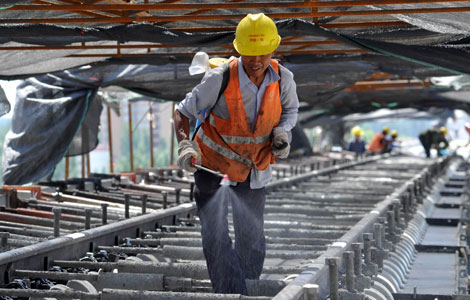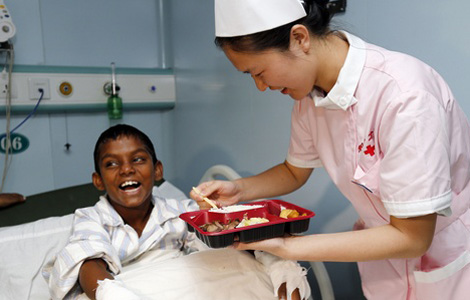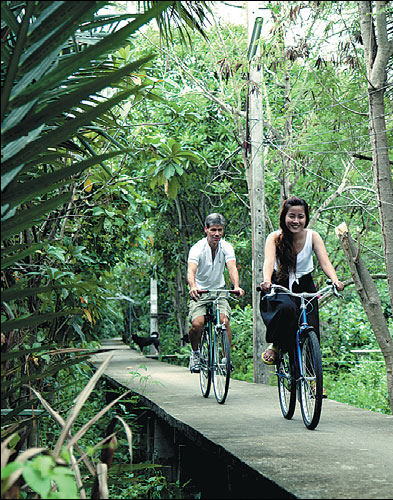Escaping to 'Bangkok's green lung'
Updated: 2013-07-14 08:07
By Ceil Miller Bouchet (The New York Times)
|
||||||||
|
Bike-friendly elevated sidewalks snaking through Bang Krachao, a smog-free, government-protected oasis of green. Provided to China Daily |
Falling coconuts, papaya groves, Buddhist temples, nine-foot-long pythons and miles of bike-friendly elevated sidewalks snaking through the jungle: Welcome to Bang Krachao, a smog-free, government-protected oasis of green that the mighty Chao Phraya River wraps around.
This verdant island is all the more remarkable because it is across the river from Bangkok. The contrast between "Bangkok's Green Lung," as the palm-choked, lung-shaped Bang Krachao is known, and the concrete jungle on the opposite bank could not be more striking. Downtown Bangkok's central Silom business district is only about six miles away.
"It's amazing how few Bangkok locals come here," said Paul Mueller, an expat American engineer who recently began running bike tours, using a growing fleet of fat-tired custom cruisers he buys from junkyards and refurbishes.
Like many others, he frequently heads into Bangkok via a regular ferry service (about five minutes to the other side of the river) and then hops on Bangkok's Skytrain mass transit system.
Mueller believes many city dwellers avoid the area because "Thais are in love with their cars," he said. "But it's hard to bring your car here because there's only one road." Yet the languid, rural way of life is evolving on this patch of wild, which is actually an artificial island because of a canal built on one side.
Bang Krachao is emerging from its time warp as more local bike tours are offered and new establishments (boutique hotels, a coffee bar) join old stalwarts (food stalls, a floating farmers' market).
Even so, mai pen rai (Thai for "no problem") could serve as the island leitmotif, according to Mueller. The laid-back feeling is a lure to a growing community of day-tripping Thais, cycling-loving tourists and expatriates.
Among the newcomers is the Bangkok Tree House, a stylish, eco-friendly boutique hotel opened last year. Cooking classes in the hotel's spacious kitchen help guests learn to cook like locals. Nearby, a bungalow resort is under construction.
Visitors can also take cooking (and incense-making) classes at the Herbal Joss Stick Home, a five-minute bike ride from the hotel.
Biking is a big draw in Bang Krachao, where most locals get around on bikes or scooters.
On a recent half-day bike tour, I pedaled slowly behind Mueller. The jungle air, full of chirps and buzzes, smelled of musty decomposing leaves.
We threaded among hamlets studded with wood-framed cottages on stilts and through shady, swampy patches sheltered by towering palm trees. As we cycled, Mueller remarked that he was not troubled by the lack of guardrails on the raised paths, the tree vipers or even the python he spotted on the road one night. His fear? Falling coconuts.
Yet even coconut-related anxieties dissipated amid the village fair atmosphere of the weekend Bang Namphueng floating market.
Crossing a humpbacked bridge, I saw a dozen small wooden vendor boats moored along a canal. They were far outnumbered, though, by covered open-air stalls set up next to the canal serving sizzling stir-fries, fragrant curries, fruit, vegetables, soaps and sweets.
A wizened saffron-robed Buddhist monk flicked holy water from a brush onto a passer-by. Children played while their parents sang karaoke and spread picnic lunches near a Technicolor temple. As we left the market area, Mueller pointed out the freshly asphalted parking lot.
"The market is growing," he said. "More city folks are coming here on the weekends." Now he has a new fear: traffic jams. "We don't want Bangkok over here," he said.
The New York Times
(China Daily 07/14/2013 page16)

 'Despicable' minions upset Depp's 'Lone Ranger' at box office
'Despicable' minions upset Depp's 'Lone Ranger' at box office
 'Taken 2' grabs movie box office crown
'Taken 2' grabs movie box office crown
 Rihanna's 'Diamonds' tops UK pop chart
Rihanna's 'Diamonds' tops UK pop chart
 Fans get look at vintage Rolling Stones
Fans get look at vintage Rolling Stones
 Celebrities attend Power of Women event
Celebrities attend Power of Women event
 Ang Lee breaks 'every rule' to make unlikely new Life of Pi film
Ang Lee breaks 'every rule' to make unlikely new Life of Pi film
 Rihanna almost thrown out of nightclub
Rihanna almost thrown out of nightclub
 'Dark Knight' wins weekend box office
'Dark Knight' wins weekend box office
Most Viewed
Editor's Picks

|

|

|

|

|

|
Today's Top News
Four GSK China execs held for investigation
Asiana survivors coping with post traumatic stress
China's Q2 GDP growth slows to 7.5%
Canada mourns victims of train accident
Air crash students return to families
Snowden says he won't release harmful US data
Local governments face financing woes
Zimmerman not guilty
US Weekly

|

|







